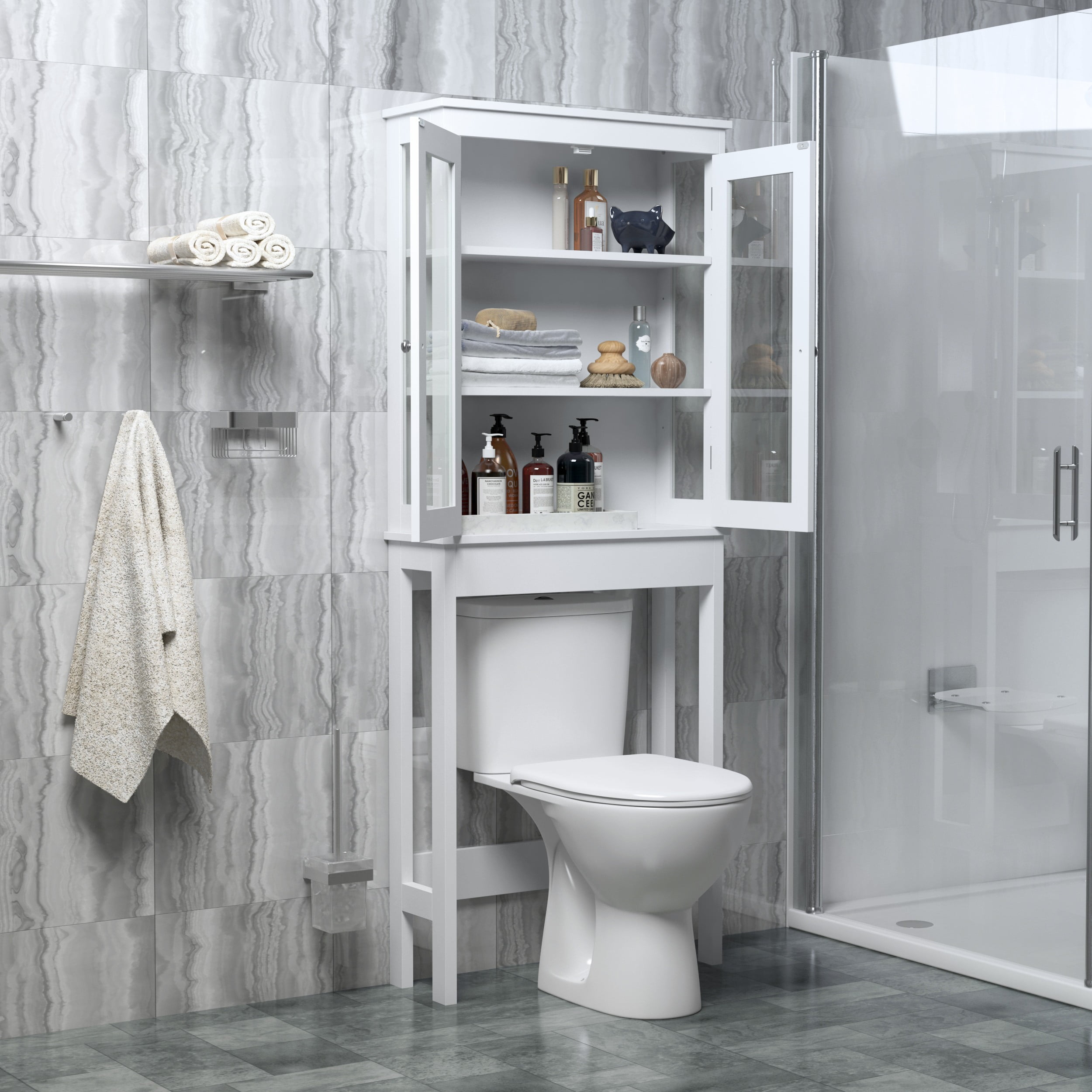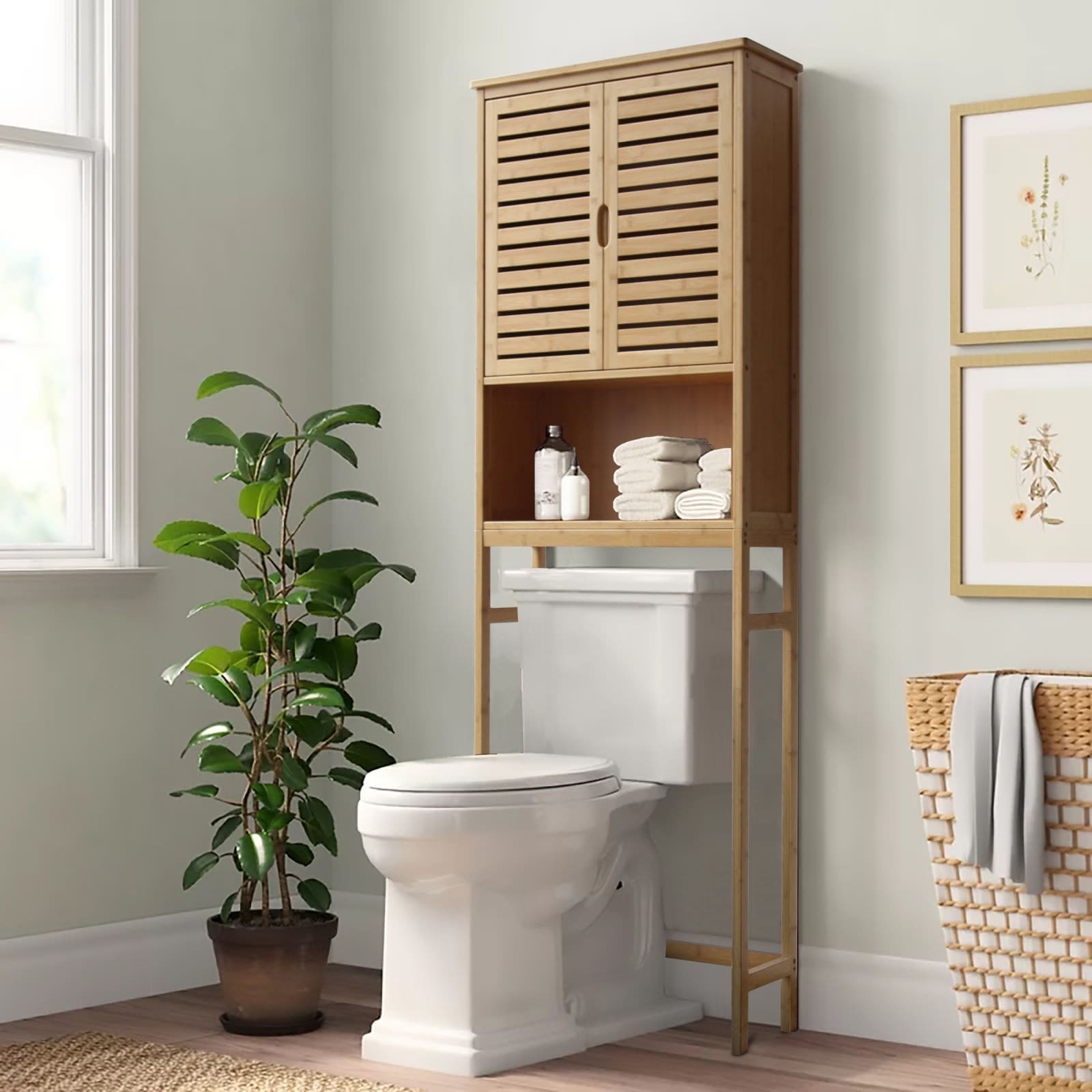Bathroom Cupboard Design and Functionality: Bathroom Cupboard Above Toilet

Transforming your bathroom into a haven of style and practicality starts with smart storage solutions. A bathroom cupboard above the toilet is a fantastic way to maximize space, organize your essentials, and elevate your bathroom’s aesthetic.
Types of Bathroom Cupboards
Choosing the right bathroom cupboard involves considering factors like material, size, and features. Here’s a breakdown of popular options:
- Wall-Mounted Cupboards: These cupboards offer a sleek and space-saving solution. They are available in various sizes and materials, including wood, MDF, and metal. Wall-mounted cupboards are perfect for smaller bathrooms as they don’t take up any floor space.
- Freestanding Cupboards: Freestanding cupboards provide ample storage space and can be placed anywhere in the bathroom. They are typically made from wood or MDF and come in a wide range of styles to complement different bathroom designs.
- Corner Cupboards: Maximize space in your bathroom with corner cupboards. These clever designs fit snugly into the corner, making the most of often-unused space. Corner cupboards are ideal for smaller bathrooms or bathrooms with limited wall space.
Material Considerations
The material of your bathroom cupboard plays a crucial role in its durability, style, and maintenance. Here’s a look at common materials and their advantages:
- Wood: Natural wood offers a timeless and elegant look, adding warmth and sophistication to your bathroom. However, wood requires regular maintenance to prevent moisture damage.
- MDF: Medium-density fiberboard (MDF) is a cost-effective and durable option. It’s readily available in various finishes and can be easily painted or stained to match your bathroom decor.
- Metal: Metal cupboards provide a modern and industrial look. They are typically more resistant to moisture and scratches than wood or MDF, making them ideal for humid environments.
Design Tips for Maximizing Storage Space
- Utilize Vertical Space: Make the most of vertical space by opting for tall cupboards with shelves or drawers.
- Install Adjustable Shelves: Adjustable shelves allow you to customize the height of the compartments, accommodating items of varying sizes.
- Consider Open Shelving: Open shelves provide easy access to frequently used items and create a sense of spaciousness.
- Add a Mirror Door: A mirrored door can visually enlarge a small bathroom and add a touch of elegance.
- Include Drawers: Drawers provide discreet storage for items you want to keep hidden.
Innovative Design Solutions for Small Bathrooms, Bathroom cupboard above toilet
- Floating Shelves: Floating shelves create a modern and airy feel while maximizing wall space.
- Multi-Purpose Storage: Choose a cupboard with integrated features, such as a built-in towel rack or a mirror, to save space and enhance functionality.
- Slim Cupboards: Opt for slim cupboards that fit snugly above the toilet without taking up too much floor space.
Visual Representation of a Bathroom Cupboard Above the Toilet
Bathroom Cupboard Storage Solutions

The bathroom cupboard above the toilet is a valuable storage space that can be maximized to keep your bathroom organized and tidy. This space is often overlooked, but it can be transformed into a well-organized storage solution for a variety of bathroom essentials.
Common Items Stored in a Bathroom Cupboard
The items commonly stored in a bathroom cupboard above the toilet vary depending on individual needs and preferences. However, some common items include:
- Toiletries: Toothpaste, toothbrushes, mouthwash, floss, shaving cream, razors, and other personal care products.
- Medications: Over-the-counter medications, vitamins, and prescription drugs.
- First Aid Supplies: Bandages, antiseptic wipes, pain relievers, and other first aid essentials.
- Hair Care Products: Shampoo, conditioner, hairspray, styling tools, and hair accessories.
- Cleaning Supplies: Toilet bowl cleaner, bathroom cleaner, glass cleaner, and other cleaning products.
- Extra Toilet Paper and Towels: Keep a spare roll of toilet paper and extra hand towels readily available.
Categorizing Items Based on Frequency of Use and Size
Categorizing items based on frequency of use and size is a crucial step in optimizing bathroom cupboard storage. This approach ensures easy access to frequently used items while maximizing space for less frequently used items.
- Frequently Used Items: Toiletries, medications, and first aid supplies are typically used daily and should be easily accessible. These items can be stored on lower shelves or in designated baskets for quick retrieval.
- Less Frequently Used Items: Hair care products, cleaning supplies, and extra towels are not used as often and can be stored on higher shelves or in less accessible areas of the cupboard.
- Large Items: Towels, hair dryers, and other large items should be stored on the bottom shelves or in dedicated storage solutions to avoid overcrowding.
- Small Items: Small items, such as cotton balls, Q-tips, and medications, can be organized in small containers or baskets to keep them contained and easily accessible.
Optimizing Storage Space
Maximizing storage space in a bathroom cupboard requires a strategic approach to organization. Here are some tips for optimizing storage space:
- Shelves: Adjustable shelves allow you to customize the height of the shelves to accommodate different sized items. This provides flexibility in organizing items based on size and frequency of use.
- Baskets: Baskets are an excellent solution for organizing smaller items, such as toiletries, medications, and cleaning supplies. They can be stacked or placed on shelves to create a visually appealing and functional storage system.
- Organizers: Drawer organizers, tiered trays, and rotating shelves are helpful for maximizing space in a small cupboard. They provide a dedicated space for each item, preventing clutter and making it easier to find what you need.
Storage Solutions for Specific Bathroom Needs
Specific bathroom needs require tailored storage solutions. Here are some examples:
- Toiletries: A tiered tray or a small drawer organizer can be used to store toiletries, keeping them organized and easily accessible.
- Cleaning Supplies: A designated shelf or a basket can be used to store cleaning supplies, keeping them separate from other bathroom items.
- Towels: A dedicated shelf or a hanging towel rack can be used to store extra towels, ensuring they are readily available.
Bathroom Cupboard Layout
A well-designed bathroom cupboard layout incorporates various storage solutions to accommodate all bathroom essentials. Here is a sample layout:
- Top Shelf: Store less frequently used items, such as extra towels, hair care products, and cleaning supplies.
- Middle Shelf: Use adjustable shelves to accommodate frequently used items, such as toiletries, medications, and first aid supplies. Consider using baskets or organizers to further categorize items.
- Bottom Shelf: This shelf can be used for larger items, such as hair dryers, styling tools, or extra toilet paper rolls.
Bathroom Cupboard Installation and Maintenance

Installing a bathroom cupboard above the toilet can be a rewarding DIY project, adding valuable storage space and enhancing the functionality of your bathroom. This guide provides step-by-step instructions and essential tips for successful installation and long-lasting maintenance.
Tools and Materials
The necessary tools and materials for installing a bathroom cupboard above the toilet are crucial for a safe and efficient installation. You will need a measuring tape, pencil, level, drill, screwdriver, stud finder, wood screws, anchors, and a saw.
- Measuring Tape: Accurately measure the space above the toilet to determine the size of the cupboard needed.
- Pencil: Mark the location of the cupboard on the wall for accurate placement.
- Level: Ensure the cupboard is installed horizontally and securely.
- Drill: Create pilot holes for screws and install anchors in the wall if necessary.
- Screwdriver: Securely fasten the cupboard to the wall using wood screws.
- Stud Finder: Locate wall studs for maximum stability and support.
- Wood Screws: Securely attach the cupboard to the wall studs.
- Anchors: Provide secure mounting in drywall or plaster walls.
- Saw: Cut the cupboard to size if necessary.
Installation Steps
The installation process involves careful measurements, securing the cupboard to the wall, and ensuring stability and safety.
- Measure and Mark: Carefully measure the space above the toilet and mark the desired location on the wall using a pencil. Ensure the cupboard is centered and level.
- Locate Studs: Use a stud finder to locate wall studs for maximum support.
- Drill Pilot Holes: Drill pilot holes for the wood screws to prevent splitting the wood.
- Install Anchors: If installing into drywall or plaster, use anchors for added support.
- Secure the Cupboard: Attach the cupboard to the wall studs using wood screws. Ensure the screws are long enough to penetrate the wall stud and provide a secure hold.
- Level and Adjust: Use a level to ensure the cupboard is horizontal and adjust as needed.
Safety Considerations
Safety is paramount when installing a bathroom cupboard. The following tips ensure the cupboard is securely installed and meets safety standards.
- Secure Mounting: Use appropriate mounting hardware and techniques to ensure the cupboard is securely attached to the wall and will not fall.
- Weight Capacity: Ensure the cupboard’s weight capacity is sufficient for the items you intend to store.
- Distance from Toilet: Install the cupboard at a safe distance from the toilet to avoid any obstruction or interference.
- Accessibility: Ensure the cupboard is easily accessible for retrieving and storing items.
Maintenance
Regular cleaning and maintenance are essential to keep your bathroom cupboard looking its best and functioning properly.
- Cleaning: Regularly dust and wipe down the cupboard using a mild cleaning solution.
- Hardware: Check the hinges, handles, and other hardware for signs of wear or damage and replace them as needed.
- Ventilation: Ensure adequate ventilation to prevent moisture buildup and mold growth.
- Troubleshooting: If you encounter any issues, such as a loose door or a broken hinge, address them promptly.
Example Installation
“To install a bathroom cupboard above the toilet, first, measure the space and mark the desired location on the wall. Then, use a stud finder to locate wall studs for secure mounting. Next, drill pilot holes and install anchors if necessary. Secure the cupboard to the wall studs using wood screws. Finally, level the cupboard and ensure it is securely attached.”
